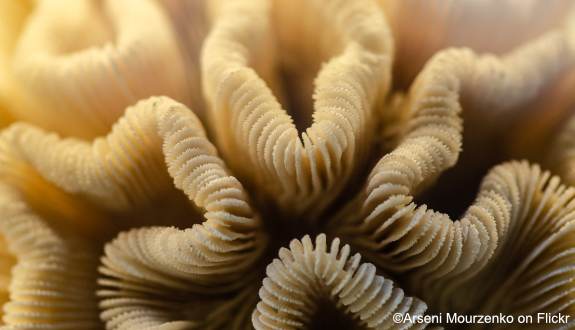

Alternative species (click on the thumbnail to see the card)
Names
Scientific name
Trachyphyllia geoffroyi
Wellsophyllia radiata (formerly)
Common name
Open brain coral
Brain coral
Folded brain coral
Crater coral
Wulstkoralle (DE)
Origin

Origin: Indo-Pacific, Red Sea
Kind

Kind: Hard Coral with long polyp (LPS)
Form: its original shape is in "8" but it can also be hemispherical (in half-sphere)
Group

Merulinidae
Volume

200 L / 44 imp gal / 53 US gal
Parameters

T°: 23 to 26°C or 73 to 79°F
pH: 7.5 to 8.5
Density: 1021 to 1024
Difficulty

Easy
Size

8cm-3.2" (skeleton) and 20cm-8" with tentacles
Brewing

Low
Lighting

Average
Aggressiveness

Low
Food
How to feed the Open brain coral?
Food
How to feed the Open brain coral?

Like many corals, Trachyphyllia gets part of its food from zooxanthellae. These are microscopic algae that grow directly in the coral with the help of light. Under strong light, the zooxanthellae can perfectly suffice to feed your Trachyphyllia.
If it is located in the shade, you will have to supplement its diet: once a week for a large specimen, every two weeks for smaller animals. Place a small piece of mussel or peeled shrimp near its mouth (2-3 mm / 0.08-0.12") is enough). Plankton is also recommended.
In nature, this coral feeds at night. It therefore takes out its tentacles to hunt only at night. It is therefore preferable to feed it at this time but you can acclimatize your coral little by little to hunt during the day (in this case, always offer food at the same time).
Cohabitation
Who can live with the Open brain coral?
Cohabitation
Who can live with the Open brain coral?
You can leave it alone in your aquarium or form a colony. You can associate it with other corals of the family Dendrophylliidae, Caryophylliidae and Fungiidae.
Beware of cohabitation with some LPS fishes like Tomentosus or Chelmon.
Breeding
How to breed the Open brain coral?
Breeding
How to breed the Open brain coral?
The multiplication of this species is carried out by division of the foot or by budding by separating the rejects formed at the base of the foot.
Its aquarium
Which aquarium for the Open brain coral?
Its aquarium
Which aquarium for the Open brain coral?
Ideal to fill your open spaces on the sand, this coral will nicely dress the bottom of your aquarium. Give it enough space to inflate at will (10 cm all around will do the trick).
Moreover, this coral when it is green or brown seems to support the light well and should be installed in a clear place, but always in the depth of the tank (average light intensity). The red or blue varieties should be placed in mid-shade, away from an overhang (low light intensity). Under blue light, they become phosphorescent!
For the current, a light gentle stirring is appreciated but never direct the current directly at it (no strong stirring that damages it).
Good To know
Find all additional information!
Good To know
Find all additional information!
Its beautiful colors range from metallic green to intense red through pink and blue. They become fluorescent under a blue light!
Yours photos!
Comments
Sort by:
Please login to post comments


